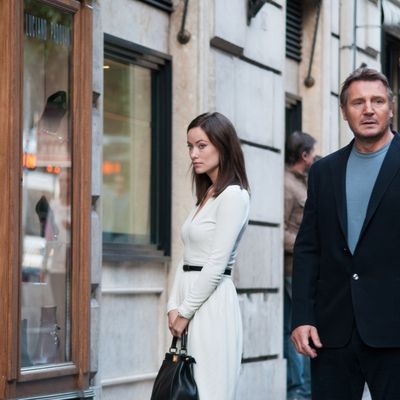
It’s not so much that Paul Haggis is a bad filmmaker but that his talents seem so unsuited to what he apparently wants to do. Crash purported to be a hard-hitting look at assumptions about race and class in Los Angeles, but its characters and situations felt so contrived — as if they’d been manhandled into place in order to illustrate Important Themes — that it set off bullshit detectors left and right. (Yes, yes, it won Best Picture … and this is a tricky game to get into, but there seem to be few Best Picture winners that are more hated.) Haggis’s talents lie in the fabulistic, not the reflective; he can tell a story, he just can’t tell a realistic one.
In Third Person, Haggis returns to the we’re-all-connected Grand Statement structure of Crash, but he’s wisely foregrounded the artificiality. It starts on the image of a writer (Liam Neeson) at work, hearing a child whisper, “Watch me,” somewhere offscreen; the ensuing film cuts between several different scenarios, all riffing off the ideas of watching, and writing, and children. There’s the writer himself and his weird, game-playing, sex-drenched tryst in an elegant Paris hotel with a beautiful, younger journalist (Olivia Wilde). There’s an ugly American fashion knockoff artist (Adrien Brody) who wanders into an Italian dive called the “Bar Americano” (because he thinks he might be able to get a Budweiser and a burger) and meets a mysterious Roma woman (Moran Atias). There’s also a poor, divorced mother (Mila Kunis) fighting for custody of her young child with her hot-headed, hotshot artist ex-husband (James Franco), in the wake of a near-death incident she may have caused.
It doesn’t take a genius or a grad student in post-modernism to figure out fairly early on that Neeson’s writer is more than just another story line that the film is cutting to — that all these are, effectively, his creations in the book he’s writing. (Sample line in said book: “White. The color of trust. It’s the color of honesty. And the color of the lies he tells himself.”) It’s a smart move on Haggis’s part to embrace the manufactured quality of his creations, but it doesn’t inoculate him against their phoniness, as we jump from one far-fetched scenario to another.
Or rather, they feel far-fetched, even when they’re not. Kunis’s story line in particular, with its portrait of a desperate woman whose descent into poverty is quickly removing all agency from her life, has all sorts of real-world resonances, but Haggis seems incapable of crafting believable dramatic situations or exchanges; the results are manipulative, and, worse, uninvolving – even though Kunis herself is at her vulnerable best.
At the same time, however, I could have watched an entire film of Adrien Brody’s story line, not just because his commedia dell’arte face seems right for this kind of arty fable, but also because the tale’s hermetically sealed, timeless quality — with its end-of-the-world dive bar, its exotic siren in a low-cut red dress, and its fanciful duplicities — renders it just artificial enough that you don’t mind the implausibility (with the one giant caveat that pop culture needs to retire the damaging Myth of the Mysterious Gypsy, pronto). Neeson and Wilde’s strand, in the meantime, offers an intriguing contrast between his melancholy reserve and her manic physicality, but it doesn’t really go anywhere, with the story eventually settling on trying to make great revelations about what different elements in the various stories mean, and how they connect to each other. (Again with the connections!)
Haggis doesn’t have the facility with naturalism that allowed Robert Altman’s multicharacter, multistrand movies to feel like parties you could disappear into. Nor does he have the gliding intricacy of a Max Ophuls, who created exquisite moral merry-go-rounds in films like La Ronde. His work is neither messy enough nor clean enough to pull off this kind of material. What he does have, however, is a flair for the evocative, and for the small, quiet moment. Early on in Third Person, we watch a host of emotions dance on Olivia Wilde’s face as she walks through a hotel corridor on her way to see Neeson for the first time; her demeanor goes from exuberance to fear to doubt to composure all in the space of those few steps. A couple of similarly quiet points later in the film resonate with this earlier walk. They make you wish Haggis would put away the Great Themes, the belabored dialogue, the forced narrative dynamics, and just figure out a way to scale down his scope and tell smaller stories. Maybe it’s not all as connected as he thinks.





